What is Stamp Duty?
Stamp duty is the tax levied on the legal documents used for the sale or purchase, or transfer of property or assets by the government. The documents are called “instruments” chargeable of duty mentioned in section 3 of the Indian Stamp Act, 1899. The documents include bonds, deeds, promissory notes, bills of exchange, agreements, debentures, leases, affidavits, and other legal documents. To make any document legally binding, stamp duty needs to be paid to state governments. Through online stamp duty payment, one can easily make any document legally valid and enforceable.
Even though there is one unified Indian Stamp Act, the state governments levy their own laws according to the State Amendment Acts and enforce charges and rates complying with the state stamp act. Stamp Duty policies vary from state to state and depend on the market value of the property, land laws, property laws, IT acts, and even age & gender as well. The central stamp duty is levied on specific instruments, and the central government determines the rate.
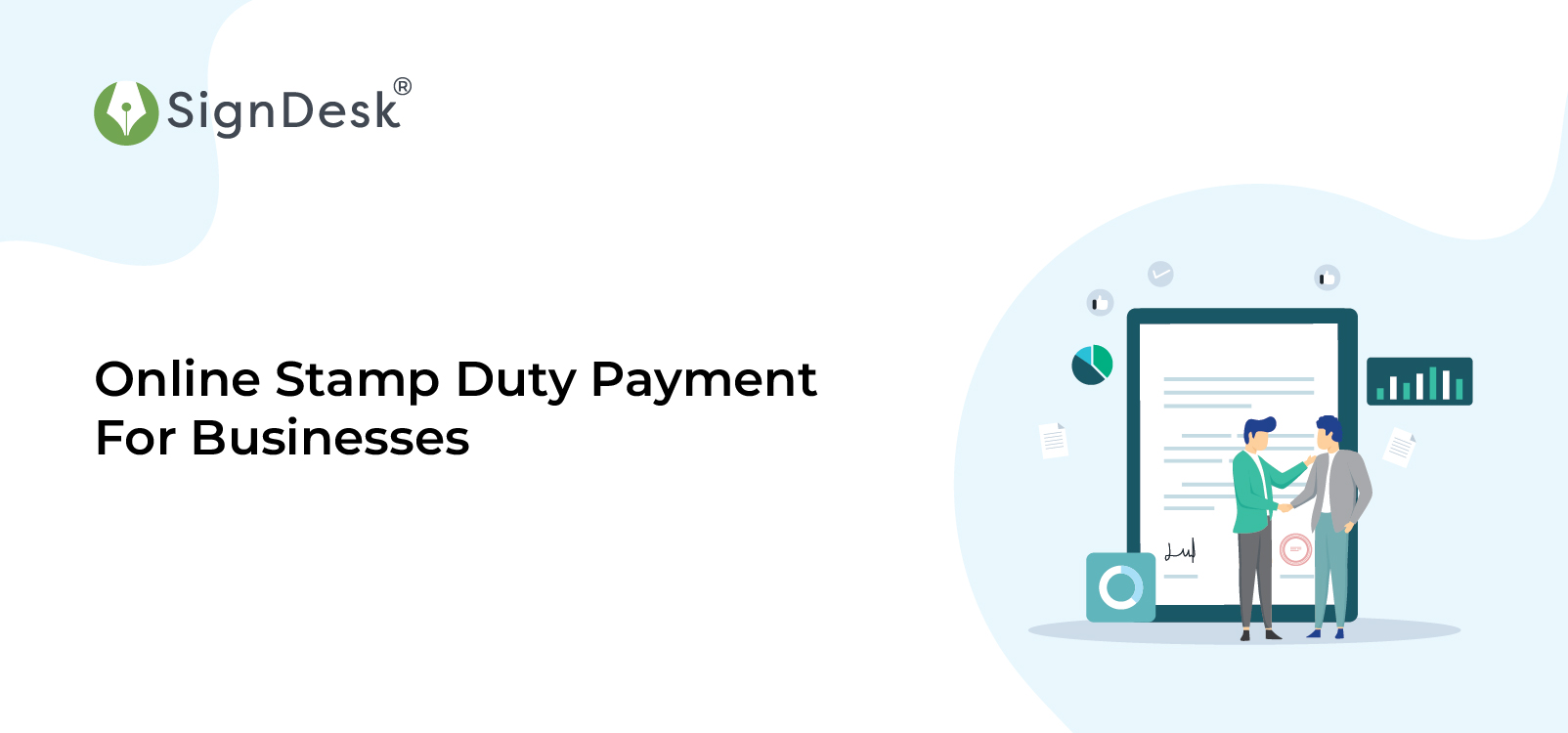
Stamp duty is State subject according to the constitution. Stamp Duty can be paid in a conventional way certified by the jurisdictional sub-registrar on or before the date of document execution. But the traditional way of paying stamp duty is a tedious process as it takes a vast amount of time for a complete stamping execution.
In the modern digital era, physical paper-based workflows are gradually becoming obsolete, and AI & ML technologies are pioneering digital workflows to upgrade the paper-based methods of stamp duty payment. Digital transformation has made its way to the stamping process as well. Business firms, legal entities, entrepreneurs, and other sectors are implementing digital stamping workflow for fast and instant real-time online stamp duty payment.
What Are the Legal Requirements for Stamp Duty?
Stamp duty acts as evidence of ownership in the court if disputes arise. Stamp duty is the additional cost one has to bear while purchasing or selling property, transferring assets, property, and shares, hypothecation, delivering products from one place to another, or making any document legally valid. One can simply avoid stamp duty payment while dealing with the above-mentioned legal activities. But to prove ownership in the future, stamp duty is essential and the only way to seek legal remedies. Online stamp duty payment is an easy and quick way to fulfill legal requirements.
- Admissible Evidence
If stamp duty is not paid, the document is not legally valid. The court or any other legal authority can not accept the document and provide admissible evidence to support the document legally.
- Document Registration
The instrument is registered in the government database as a valid document. With the serial number of stamp papers, data of any duty transaction can be checked. The document’s authenticity can be verified with the unique certificate number or associated e-challan. Stamp paper, once used, can not be reused for another instrument.
- Securing Legal Remedy
Stamp duty is rendered in full. Any citizen abiding by the law can seek juridical remedy in the case of a lawsuit. The party should pay the full amount of stamp duty at one time.
- Consequences of Non-payment
If the stamp duty is not paid, the document is not legally supported and can be treated as a fake document. The ownership cannot be verified. Therefore, it is essential that the stamp duty is paid on time. The delayed payment can cause specific costs or penalty fines. In Chapter VII, “Criminal Offences and Procedures” of the Indian Stamp Act, the penalties are mentioned in detail from Sections 62-72. If someone wants to avoid stamp duty payment, but later the document is brought to light, the stamp duty can be tenfold with some criminal offenses.
- Criminal Charges
If someone is associated with some purchase or sale of any property without paying stamp duty, it is against the law and government listing. The document is unregistered and the associated responsible person can be held liable for criminal charges.
Types of Stamp Duty Payment
Stamp Duty can be paid in multiple ways. The convenience level varies for these different types of methods. Types of stamp duty payment can be broadly classified into three categories.
- Physical Stamping
- E-stamping
- Digital Stamping
The type of stamp duty is visible on the instrument. The registered stamped document shows the method of payment and the nature of stamp duty.
Physical Stamping
Physical stamping is the traditional way of paying stamp duty using a paper-based medium. Physical stamping can be done in three ways, as described below.
- Adhesive stamps
The Adhesive stamps are used for specific classes of documents as enumerated in Section 11 of the Indian Stamp Act. The cost of the stamp duty is affixed on the first page of the document. The specific stamp duty format is the proof of the document being stamped. Such stamp papers can be availed from licensed stamp vendors or government treasuries.
- Impressed stamps
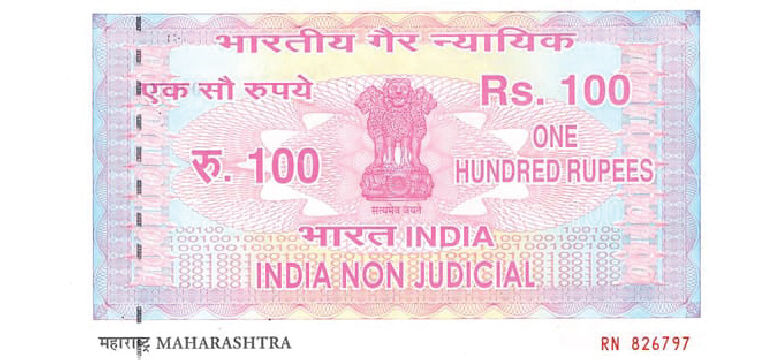
Impressed stamp papers are mostly used in physical stamping as it denotes the conventional way of stamping. Impressed stamps are such stamps that are embossed or engraved. They are usually printed on security presses. The stamp papers have serial numbers, denomination details, name of the issued state, and the stamp certificate number. Impressed stamp papers contain translucent images and a security strip on the left making them impossible to replicate. Such stamp papers can be obtained from authorized stamp vendors or legal authorities.
- Franking
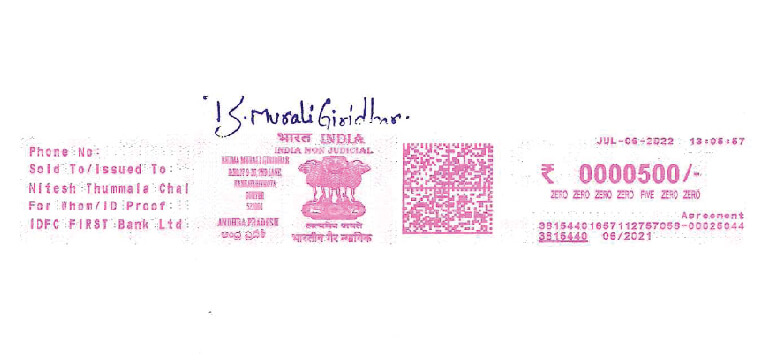
Franking is a part of stamp duty payment that includes impressing an instrument with “Red” ink. The franking is done by authorized franking machines issued by the government. The process of franking requires documents embossed with the mark on the first page of the instrument to make it legally valid, indicating the levied stamp duty has been paid. The markings include a few details of the stamp duty payment, such as serial number, name, address of the purchaser, purchased stamp value, and license number of the authorized entity. The franking machines are available from licensed stamp vendors, authorized banks, or postal offices. Franking charges can vary between 0.1% – 3% from state to state. Franking charges are lesser than stamp duty and act as proof of stamp duty payment.
5 Reasons Why You Should Avoid Physical Stamping
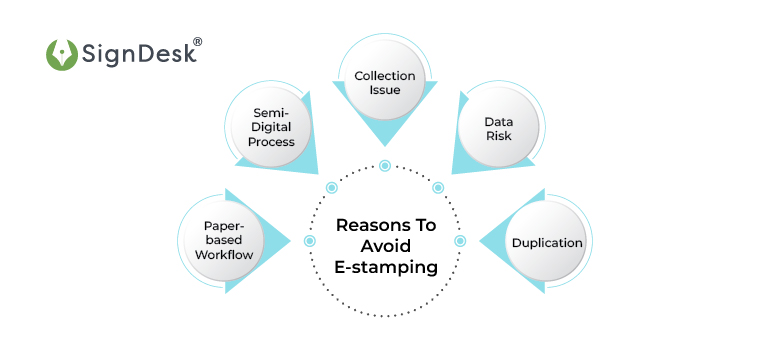
- Counterfeit Stamp Papers
Many Authorized Vendors buy stamp papers and print more stamp papers illegally. This leads to fake stamp paper and scams and revenue loss.
- Logistical Challenges
In physical stamping customer has to wait for the availability of the stamp paper after application submission. The vendor has limited stock of stamp papers per day. Therefore, the physical stamping workflow gets delayed.
- Revenue Loss
The physical stamping process involves several expenses for inventory, transport & storage; additionally there’s no way to check the authenticity of the stamp paper.
- Time-Consuming
The whole process of physical stamping is paper-based. From application to getting the documents stamped is a time-consuming process and the customer needs to wait in every stage of the process.
- Physical Damage
In the paper-based workflow, there is a high risk of physical damage to stamp papers and paper loss.
E-Stamping
E-stamping is the secure process of making online stamp duty payment while the paperwork is done per physical procedures. One can opt for online stamp duty payment using two methods.
- SHCIL eStamp
Stock holding corporation of India limited (SHCIL) is the integrated official web portal for online stamp duty payment. The CRA- Central Record Keeping Agency stores all transactional data in its centralized database. Many states have incorporated SHCIL to administer the eStamping process to prevent fraudulent activities and fake stamp paper procurement.
E-Stamping through the SHCIL portal follows these steps.
-
- Find an authorized stamp vendor licensed by SHCIL.
- Notify the vendor providing details about the denomination and quantity of required stamp papers.
- Vendors use their accounts for online stamp duty payment and convenience fees on the SHCIL portal digitally.
- Vendor prints the e-Stamp certificate and provides the certificate for physical evidence.
- NeSL DDE
NeSL stands for National e-Governance Services Limited. It is India’s first Information Utility under the aegis of the Insolvency and Bankruptcy Code, 2016, and registered with the Insolvency and Bankruptcy Board of India (IBBI). It acts as a repository of legal evidence holding the transactional digital record relating to any debt. For online processes, NeSL has set up a platform named DDE i.e. Digital document Execution to keep all data secured. E-Stamping can be processed through the NeSL platform in real-time remotely. But this facility can only be accessed by financial institutions like registered banks and NBFCs. Authorized stamp vendors can not use this for commercial or personal use.
- eSBTR
eSBTR stands for electronic Secure Bank & Treasury Receipt which is an online stamp duty payment service. eSBTR is similar to non-judicial e-stamp paper and is printed on a secured official paper provided by the Indian Security Press. It comes with in-built security features that include a watermark, background tint, perforated document logo, micro security threads, and more. All these features prevent duplication, fabrication, and fraudulent activities.
- eChallan
eChallan acts as an electronic challan or receipt that is generated after the clearance of the registration fee of online stamp duty payment. Stamp duty registration payment online is a fee that the customer has to pay for the procedure and the documentation process. It is subjected to The Registration Act, 1908, an act to consolidate the validity pertaining to the registration of documents.
Read more to know about state-specific online stamp duty payments such as eSTBR, Rajasthan eStamp, and MP eSampada.
5 Reasons Why You Should Avoid E-stamping
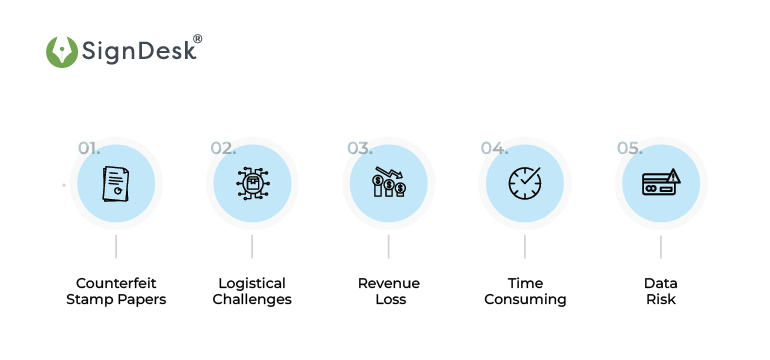
- Physical Stamping Workflow
The workflow is the same as conventional physical stamping workflow and doesn’t differ much.
- Siloed Online Stamp Duty Payment Procedure
Only payment is processed online through SHCIL or NeSL portal. Other workflows are paper-based and time-consuming.
- Physical Stamp Paper Collection
As stamp papers are official paper and printed only under government authority, the vendor has limited stock of stamp papers and can obtain those only when it is required by customers. Even though it is an online process, the customer has to submit, verify, stamp, and collect by visiting the authorized centers physically.
- Counterfeit Stamp Papers
In this workflow as well the risk of fabricated stamp paper remains high causing fraud and friction in the eStamping workflow. - Data Risk
A duplicate e-Stamp certificate can not be obtained once it has been issued.
Digital Stamping
Digital Stamping is the complete remote process of online stamp duty payment to pay stamp duty online in a paperless workflow. Anyone can make Online stamp duty payment from the comfort of their home without having to go to the post office or sub-registrar’s office or without seeking any authorized legal vendors or legal authority.
RegTech firms provide avant-garde tech solutions powered by AI & ML technology to digitize the whole process of online stamp duty payment. The complicated strenuous process of stamping becomes fast and simple through digital stamping.
To execute the complete process, multiple procedures can be followed. Digital stamping can be done in the API platform, or through SHCIL and NeSL portals.
|
E-stamping |
Digital Stamping |
|
Still Paper-based |
100% Paper-Free |
|
90% Physical Stamping Procedure |
Digital Workflow |
|
Optional Online Payment |
Online Real-time Payment |
| Lengthy Process |
Fast Process |
|
Physical Paper Procurement |
Electronic Copy along with Certificate Number is provided |
| Risk of Duplication |
Unique Digital Process |
| Revenue Loss |
Audit Monitoring |
Digital Stamping Workflow
Digital stamping can be done on the API platform or through the CLM platform remotely in a completely digital way. The common process of digital stamping follows these simple steps.
- Log In → Visit the specific website and log in to the online digital stamping portal to commence online stamp duty payment procedure.
- Upload → Upload or draft the documents that need to be stamped. One can upload documents in bulk. The digital platform caters to a vast variety of custom-made templates to compose legally valid documents from scratch.
- Input Stamping Details → Enter the relevant information regarding stamping such as stamp transaction amount, stamp denominations, name and details of the participating parties, and the state involved in the stamping process.
- Pay Stamp Duty →After the document submission and successful document review, the user requires to make online stamp duty payment to complete the stamping process. Online stamp duty payment can be paid in multiple payment methods such as net banking, credit or debit cards, cheques, pay orders, Account to Account transfer, NEFT, RTGS, or demand draft (DD). The digital platform makes this process even more convenient by providing a digital wallet facility to expedite the online stamp duty payment procedure and money loss.
- Execution → The process doesn’t end at stamp duty payment. Without proper execution, the process is not complete. After the document is stamped, it is merged with the requested stamp paper making the document ready to download.
- E-certificate → After the stamp paper is procured electronically, the user receives the e-Stamp certificate which can be verified with a unique QR code.
- Unique Certificate Number → The issue date is mentioned on the e-stamp certificate along with a one-of-a-kind unique certificate number.
Integrated Digital Stamping Services For Semi & Fully Digital Procurement
SignDesk is a SaaS-based RegTech firm that offers digital stamping solutions to over 25+ Indian States and Union Territories. It offers a complete digital stamping process where the customer does not need to visit any brick-and-mortar authorized center and even receive the physical stamped document at the end of the process.
- Partnership with SHCIL
SignDesk has partnered with 4 state governments i.e. Karnataka, Tamil Nadu, Delhi, and Gujarat to pay stamp duty digitally. The API platform streamlines the whole digital stamping process efficiently and effectively.
The digital process of paying online stamp duty payment through the SHCIL portal follows a few steps.
The RegTech firms act as a crucial trustworthy medium between the legal authority, SHCIL, and the customer. To digitize the process the intermediary firm buys stamp papers from SHCIL as per the need of the customer. In this way, there is a sufficient amount of stamp paper to continue with the process. The firm gets the serial numbers of stamp papers. When the online stamp duty payment is rendered in full, the customer gets the receipt along with the serial number of the stamp papers. At the end of the month, the firms deliver the physical stamp papers to the customers for physical evidence of online stamp duty payment.
- Partnership with NeSL-DDE
SignDesk is associated with NeSL (National e-Governance Services limited) for the IU (Information Utility) and DDE (Digital Document Execution) services. IU is an organization that acts as a compendium of authenticated safe and accurate financial information pertaining to debt and associated parties. IU is extensively associated with DDE for the digital stamping method.
SignDesk provides a common digital safe ground for multiple vendors or customer-client to present relevant data to parties enquiring about it. Additionally, NeSL partners with SHCIL to provide e-stamping services to legalize documents before submitting them as debt-related evidence to an IU.
Legal entities need to provide a Digital Signature Certificate (DSC) to register with an IU. They do this using a Certifying Authority (CA) to obtain DSCs. SignDesk acts as the Application Service Provider (ASP) to provide digital stamping services integrated with NeSL which is operational nationwide. Digital stamping is the most desirous digital stamping process for business firms as well as tech-savvy entrepreneurs seeking regulatory digital revolutionary automation to break through the conventional slow stamping workflows adhering to the security regulations of the IT Act (2000).
State-Wise Stamp Duty Payment Methods
| Sl.no | State Name | Impressed Stamp | e-Stamp availability | Franking Availability | Adhesive Stamp |
| 1 | Andhra Pradesh | ✔ | ✖ | ✖ | |
| 2 | Arunachal Pradesh | ✔ | ✖ | ✖ | |
| 3 | Assam | ✖ | ✔ | ✖ | |
| 4 | Bihar | ✖ | ✔ | ✖ | |
| 5 | Chhattisgarh | ✔ | ✔ | ✖ | |
| 6 | Goa | ✔ | ✖ | ✖ | |
| 7 | Gujarat | ✖ | ✔ | ✖ | |
| 8 | Haryana | ✔ | ✔ | ✖ | |
| 9 | Himachal Pradesh | ✔ | ✖ | ✖ | |
| 10 | Jharkhand | ✖ | ✔ | ✖ | |
| 11 | Karnataka | ✖ | ✔ | ✖ | |
| 12 | Kerala | ✔ | ✖ | ✖ | |
| 13 | Madhya Pradesh | ✔ | ✔ | ✖ | |
| 14 | Maharashtra | ✔ | ✖ | ✔ | |
| 15 | Manipur | ✔ | ✖ | ✖ | |
| 16 | Meghalaya | ✔ | ✖ | ✖ | |
| 17 | Mizoram | ✔ | ✖ | ✖ | |
| 18 | Sikkim | ✔ | ✖ | ✖ | |
| 19 | Nagaland | ✔ | ✖ | ✖ | |
| 20 | Odisha | ✔ | ✖ | ✖ | |
| 21 | Punjab | ✔ | ✖ | ✖ | |
| 22 | Rajasthan | ✔ | ✔ | ✖ | |
| 23 | Tamil Nadu | ✔ | ✖ | ✖ | ✔ |
| 24 | Telangana | ✔ | ✖ | ✔ | |
| 25 | Tripura | ✖ | ✔ | ✖ | |
| 26 | Uttarakhand | ✔ | ✔ | ✖ | |
| 27 | Uttar Pradesh | ✖ | ✔ | ✖ | |
| 28 | West Bengal | ✔ | ✖ | ✔ | ✔ |
| 29 | Andaman & Nicobar Islands | ✖ | ✔ | ✖ | |
| 30 | Chandigarh | ✖ | ✔ | ✖ | |
| 31 | Dadra and Nagar Haveli and Daman & Diu | ✖ | ✔ | ✖ | |
| 32 | Delhi | ✖ | ✔ | ✖ | |
| 33 | Jammu & Kashmir | ✖ | ✔ | ✖ | |
| 34 | Ladakh | ✖ | ✔ | ✖ | |
| 35 | Puducherry | ✔ | ✔ | ✖ |
Enable Easy Stamp Procurement With Real-Time Digital Stamping
SignDesk provides a state-of-art digital stamping solution (stamp.it) powered by smart technology. Digital Stamping can expedite the process without any friction in real time. Stamp duty can be paid instantly with documents signed and stamped from anywhere using a secured digital platform.
With enterprise-grade ISO and GDPR-compliant digital stamping solutions, business firms can see the significant operational impact –
- Paperless Accelerated Workflow
The AI tool streamlines digital stamping documentation workflow increasing the speed of document execution 1.5x faster.
- Reduced Expenses
With digital stamping the denomination issue is solved. With the digital wallet facility, the customer does not need to pay extra charges to match the denomination during the online stamp duty payment process. The cost of eStamp paper procurement becomes 50% lower than the physical process.
- High Visibility and Access
The customer can monitor the whole stamping process remotely with 24/7 access and support. It offers a superior place to keep a track of stamp duty payments and obtain the eStamping certificate easily on the same digital platform.
- Enhanced Security
In the paperless workflow the chances of fraud and fabrication are low and the highly secured repository keeps all data safe and sound preventing cyber crimes with AML compliance.
- Bulk Digital Stamping
Business organizations can easily opt for a digital stamping solution that offers bulk document execution and real-time online stamp duty payment for digital stamping to meet business goals fast in an efficient way. SignDesk’s digital stamping solution can execute 1000+ agreements per minute.
Empower yourself to maintain regulatory compliance by executing legally binding documents with instant online stamp duty payment. Get your documents verified and stamped instantly within a few minutes without finding any licensed stamp vendor and worrying about authenticity.